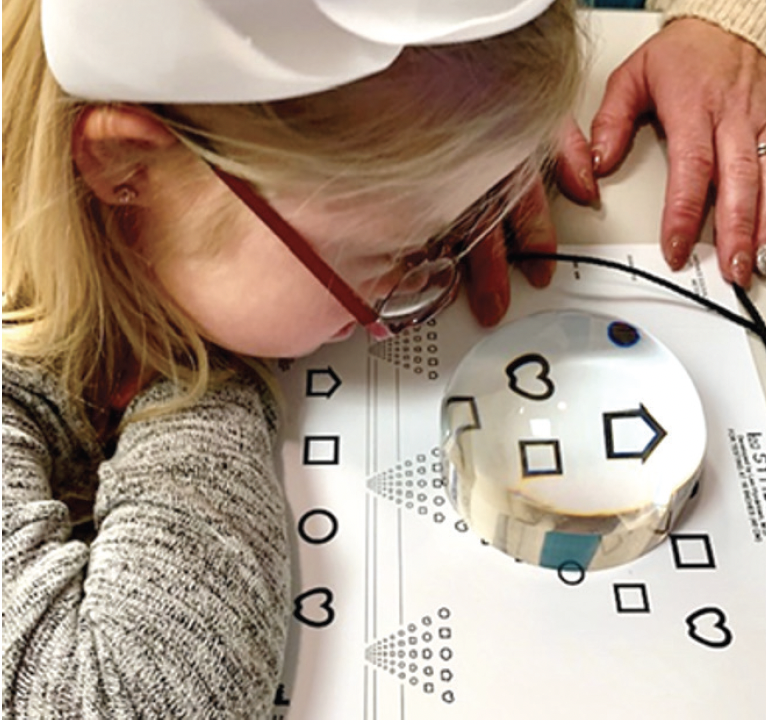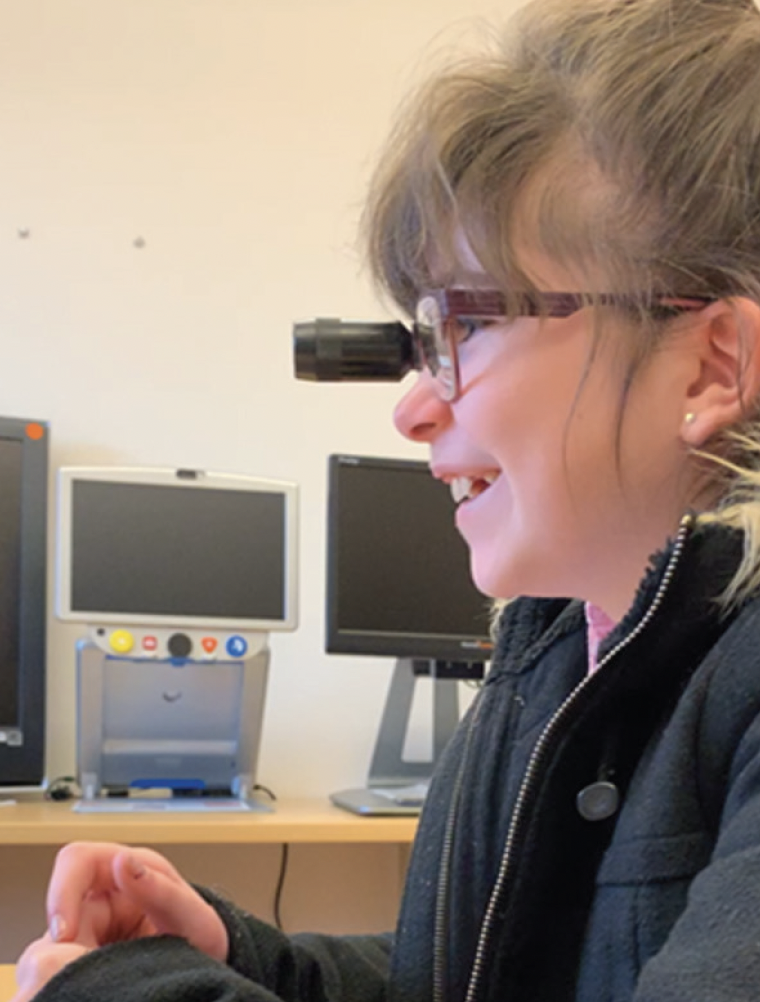Vision Rehab for Pediatrics Continuing Education June 2017
At A Glance
- Low vision is reduced visual acuity that cannot be corrected with glasses, contact lenses, or other medical treatment.
- Childhood vision impairment can lead to delayed motor, language, emotional, social, and cognitive development, all of which can have lifelong effects.
- Low vision rehabilitation should begin early as a parallel, ongoing treatment modality, not as a last resort when all other medical approaches fail.
What is low vision? According to the National Eye Institute, low vision (LV) is defined as having a BCVA of less than 20/40 in the better-seeing eye, which encompasses those categorized as legally blind by the US definition of 20/200 or worse or total visual field of 20° or less.1
In other words, LV is vision that cannot be corrected with glasses, contact lenses, or other medical treatment. In our LV clinic, we see patients of all ages whose visual deficit affects their activities of daily living.
WHAT'S AT STAKE?
In 2013, an estimated 19 million children around the world were visually impaired, including 1.4 million who were blind.2 Causes of pediatric vision impairment and blindness vary depending on the socioeconomic status of the country. In countries that lack access to preventive health care, uncorrected refractive error (myopia especially) and congenital cataracts are the main factors.3 Common causes of pediatric vision impairment in developed countries are often neurologic or cortical (ie, hypoxia, especially in premature children) and may have accompanying comorbidities.4 Additional causes include refractive or strabismic amblyopia, inherited retinal diseases, and brain tumors.
It is well documented that vision impairment in children can lead to delayed motor, language, emotional, social, and cognitive development, all of which can have lifelong effects. In addition, vision impairment is associated with lower educational levels and achievements.3 The economic impact of vision disorders in the United States alone was estimated in 2004 to be $16 billion in direct medical costs and $8 billion in loss of productivity.5 Thus, early low vision rehabilitation (LVR) intervention is key in realizing the full potential of these children.
Once vision impairment is identified in a child, a concurrent referral should be made for LVR, as well as other necessary medical treatments. LVR should be prescribed as a parallel and ongoing treatment modality, not as a last resort when all other medical treatments fail. Beginning LVR early allows the child to be connected to appropriate resources that can help him or her excel in school and live an independent life.
Purposes of Pediatric Low Vision Exams
- Determine the child's visual functioning level
- Prescribe appropriate devices, if any, to enhance functional vision in school and community
- Educate family, caregivers, and teachers about child's visual needs, including:
- Assistive technology or other adaptations the child will use
- How, when, and why to use assistive devices
- Connect with a teacher consultant for the visually impaired
- If necessary, create an individual education plan to provide the child with accommodations at school
- Refer the child to other LV team members
- Provide additional resources for the family, including:
- Referring to other specialists (ie, occupational therapy, orientation and mobility)
- State and federal agencies and resources
- Support groups
- Reevaluate child to provide or change devices or resources according to current visual acuity
PEDIATRIC Low vision EXAMS
How early can a child be evaluated by a LV specialist? The youngest patient I (SD) have seen in clinic was a 3-month-old boy who unfortunately had lost one eye due to endophthalmitis. Understandably devastated and anxious, his mom wanted to know about the future for her son, given his monocular vision. That visit initiated a dialogue not only about eye protection and continuing eye care, but also about the resources available to her son and the purposes of pediatric LV exams (see Purposes of Pediatric Low Vision Exams).
At our academic medical center, we embrace a team approach to LVR that includes an LV optometrist, an occupational therapist, and an orientation and mobility specialist. An LV evaluation begins with a thorough assessment of functional vision history to understand difficulties with distance and near tasks, computer work, social interactions (facial versus voice recognition), watching television, playing an instrument or sports, and eligibility for driver training. Then, a trial-frame refraction, contrast sensitivity, visual field, glare control, subjective task lighting needs, and additional tests are completed to select vision-enhancing devices customized to achieve the child's functional goals.
ASSISTIVE DEVICE OPTIONS
After determining the magnification needed to achieve the child's functional goals, we seek to provide that power through various devices. Near-task devices can include traditional handheld or stand-based magnifiers (Figure 1), high-powered reading glasses, and near telescopes.

Figure 1. A preschooler using a 4x dome (stand) magnifier.
With advances in technology, electronic magnification has become more accessible and portable. There are two main advantages of CCTVs (closed circuit televisions) compared to traditional magnifiers: magnification capability and contrast enhancement can be varied to suit the patient's needs. For school-aged children, we typically recommend a portable CCTV with both distance and near focusing capabilities.
Traditional distance devices include focusable telescopes. Some telescopes are ready-made binocular spectacles that can focus each eye separately for television watching. Others are monocular telescopes that can be handheld or clipped onto spectacle lenses. Custom-mounted bioptic telescopes are typically used for reading the board at school (Figure 2), seeing street signs, and driving. Telescopic glasses can be customized with a reading cap for specific tasks, such as reading music. Patients with reduced peripheral vision, such as those with retinitis pigmentosa, can use a field expander or a reverse telescope.

Figure 2. A seventh grader fitted with a focusable 6x bioptic telescope to see the board at school.
Head-mounted devices are changing the practice of LVR and have become more accessible due to competition among vendors. The OrCam MyEye (OrCam) includes a camera that can be mounted onto the temple of a spectacle frame. It gives the wearer audible clues to his or her surroundings and is known for its point-and-read and facial recognition functions ("your neighbor, Joe"). The newest generation of the device has additional features, including orientation, which lets the user know what's in front of him or her ("chair in front, table to the right"). We have prescribed this device for patients who need high magnification because the smaller field of view of traditional optical magnifier limits reading fluency.
Another popular head-mounted device is the eSight (eSight), with distance and near functions and cloud-based connection. The image from the device's camera is projected onto head-mounted screens seen by the patient. Other available devices include IrisVision (IrisVision) and NuEyes Pro (NuEyes).
For patients with glare sensitivity conditions such as cone dystrophy, we can customize glare control tints to address indoor and outdoor glare and enhance contrast. We have also prescribed red- or orange-colored contact lenses for such patients.
We usually refer children to our LV occupational therapist for non-optical accommodations, including technology accessibility functions on computers, tablets, and large print keyboards. Certain smartphone apps can help users identify colors (Color ID Free) and money denominations (NantMobile Money Reader), read text, and even connect the user to a live person to help navigate surroundings (Aira, BeMyEyes).
Unfortunately, most major insurance payers, including Medicare, do not cover LV devices, hence the importance of including these devices in a patient's individual education plan (IEP; see below). Medicaid sometimes covers traditional magnifiers, telescopes, and glare control filters, but not electronic assistive devices.
SETTING PATIENTS UP FOR SUCCESS
After an LV evaluation, we write a summary letter for the patient's school to help instructors incorporate accommodations and devices into an IEP and to communicate the recommendations to the child's teacher consultant for the visually impaired (TCVI), if one is available. An IEP is a legally required document for any child with special education needs who attends public school. TCVIs are provided by school districts to support and train children in the use of LV devices and to implement accommodations detailed in the IEP.
Our letters typically include specific details, such as the minimal font size in Times Roman that the child can read without devices, a list of devices recommended for distance and near viewing (especially portable CCTVs), computer accessibility functions and software, recommendations for orientation and mobility, and Braille training as needed. We refer patients who meet the vision criteria (< 20/70) to youth LV services and college assessment/preparation program on a college campus through Michigan's Bureau of Services for Blind Persons.6
Teens with vision impairment often want to know if they can ever drive. Most states allow the use of bioptic telescopes for driving, although vision requirements and guidelines vary from state to state. Our state requires that patients with bioptic telescopes be trained by a certified driving school that assesses patients on the road and tests patient reaction times.
A pearl for working with children: Social pressures and challenges can deter them from using devices that draw attention to their special needs. Recently, a 13-year-old patient who is legally blind told me (SD) that he would not use any CCTVs or tints, or even have the teacher enlarge any paper print for him, for fear of being seen as "different" and bullied. We counseled him on resources to help him remain competitive in school and maintain his independence. We also recommended some inconspicuous devices: a foldable 5x magnifier or a credit-card-sized 4x easyPocket magnifier (Eschenbach) that could easily fit inside his pocket, and a 6x16 focusable tube telescope that he can roll inside his palm and use, for example, when he spots a pedestrian walk sign or sees a menu on the wall.
One of the highlights of my (SD) career was when I received a thank-you card from a long-time patient of mine who had been legally blind all her life. She had been my patient from the time she was in elementary school until she went to college. In her card, she thanked me for all the devices, resources, and help over the years, which had helped her to graduate with a PhD in chemistry and to land her first job in industry. Her experience is a testament that early and continued LV intervention, including referrals to appropriate resources and specialists, is crucial to allow children with vision impairment to have the opportunity to thrive in school and become competitive in the workforce. As her example illustrates, LV rehabilitation can affect the whole life of the patient.
courvillehousight.blogspot.com
Source: https://modernod.com/articles/2021-oct/pediatric-low-vision-rehabilitation
0 Response to "Vision Rehab for Pediatrics Continuing Education June 2017"
Post a Comment